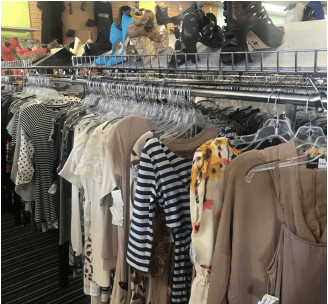While NSU’s Recyclemania is focusing mainly on recyclables that would otherwise be trashed this month, it’s important to know about the recycling potential of many of the clothes we wear on a daily basis as well. From a high fashion brand jean jacket to a vintage T-shirt, thrift stores could be your gateway to a fresh new fashion.
According to NPR, fast-fashion industries frequently use cheap, non-durable fabrics to create clothes that are in season for a few months, to then be replaced by another garment afterwards. These pieces cater to trends, and get put on the market quickly — hence being nicknamed “fast” fashion. Forbes adds that, the articles are often very cheaply made and priced, and although it may be exciting for the consumer to get an article of clothing for a few bucks, it frequently goes out of style within a few weeks and falls apart shortly after. On it’s even uglier side, fast fashion garments are usually made abroad, using slave labor, sweatshops and dangerous working conditions, all while taking jobs out of the U.S.
Alexis Good, senior marine biology major and President of NSU’s Green Sharks sustainability club, said, “Fashion can be reused by bringing [clothing] to places like Goodwill or other thrift stores. [Fast fashion] is very wasteful. I personally haven’t bought clothing in two or three years — I’m not into fast fashion. Clothes stay nice if you keep them well. You really don’t need new clothes every season.”
Luckily, there’s one simple and cost effective way to avoid fast fashions and help the environment: thrift shopping. The Independent, a British online newspaper, states that thrift shopping not only gives consumers the opportunity to find clothes that are affordable, but they save garments that may have otherwise been thrown out into a landfill. In addition, you can find stylish clothes, even those from fast fashion brands — but because you’re not giving the money directly to those companies, you’re getting the garment without supporting the cruelty behind the industry. Here are a few tips to help you on your first thrifting expedition.
Look at every garment on the racks
Sometimes walking into thrift stores can be overwhelming — with racks on racks of clothing, it can be difficult to decide where to begin. Rather than glossing over an entire section, start at the end of one aisle, and quickly flip through each garment. Sometimes items might not be in a color you’d generally wear, but it could be your newest statement piece. By quickly scanning the section, you can find clothes that you may never have reached for from the outside.
Don’t let labels hold you back
If you’re looking for t-shirts, jackets or some other specific items, don’t be afraid to go to the section of your opposite gender. A lot of clothes don’t really cater to just one gender — if you want a simple t-shirt, denim jacket or sweater, chances are you can find one in either section. Occasionally, women’s clothes end up in men’s and vice versa, anyway. The same goes for sizes — sometimes garments get thrown on incorrect hangers, or brands have completely missed the sizing scale. Don’t let any of the labels in a thrift store hold you back from perusing.
Try new stores
Goodwills aren’t the only thrift store you can go to. Sure, chain thrift stores usually have the largest selection, but that doesn’t mean you can’t get great finds at other stores. A quick search on Google can bring up plenty of local thrift stores that have different styles of clothing — some of which may be cheaper than chain store prices.
Choose wisely
The clothing in used clothing stores is exactly as marketed — used. While most stores, especially chains, have specific rules when it comes to the cleanliness of what is put on their shelves, it doesn’t hurt to give everything a once-over. Making sure each garment doesn’t have holes or stains is important. There’s nothing worse than taking home your thrift store finds, only to realize they have an oil mark on the side or a irreparable rip in the seam. Even when you’re sure the item is ready for wear, give it a quick wash before you incorporate it into your next outfit.


